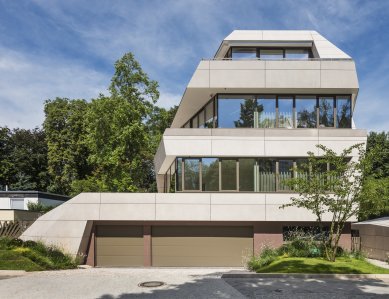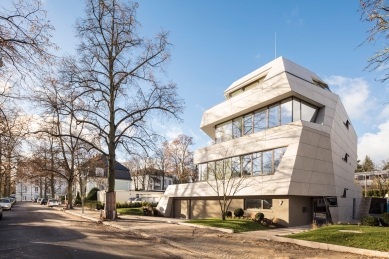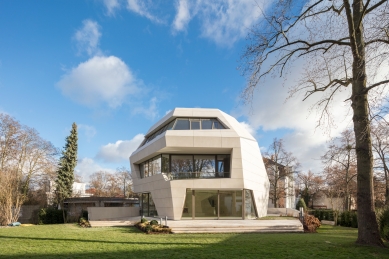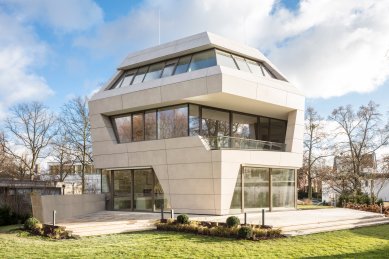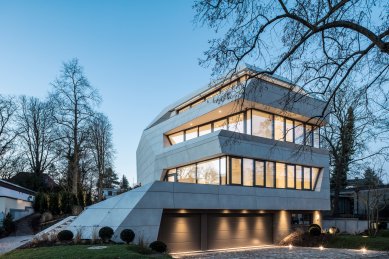
Villa M

GRAFT's design for a private villa in Berlin's venerable Grunewald quarter presents a striking, modern interpretation of comfortable living in the city. It's trapezoidal, sculptural form and modern architectural language symbolizes a boulder in a glacial landscape and differentiates it from its neighbours. The distinctive, three-dimensional figure of the four-storey building appears to rise out of the ground. For its design, GRAFT abstracted the classical rules of villa design and digitally synthesized them with natural phenomena shifting the tectonics of a villa towards those of a sculpture.
The façade is clad with ceramic plates that reinforce the impression of a large stone boulder. Horizontal incisions in the faceted surface of the façade for the loggias and floor-to-ceiling glazing are strategically placed to establish visual connections with the surrounding greenery while maintaining privacy. This asymmetrical appearance is reflected in the interiors where flowing transitions between the rooms create a sense of openness. The internal stairs and fireplace, in particular, break with residential design conventions. The centerpiece of the house is the living room, a prismatic, spacious open space designed for maximum comfort.
Aside from the kitchen and the living room, there are two additional rooms on the ground floor, a master bedroom on the upper floor as well as a large corridor, terrace and four further rooms. The top floor is a self-contained flat that can be used flexibly. The entrance, double garage, storage spaces and a spa are located on the lower ground floor. Travertine stone flooring also reinforces associations with a boulder.
The floor plans are designed to be flexible, so that they can adapt to the residents' changing life situations. Floors can be separated off into self-contained apartments, accessed via the outer staircase. The materials were chosen for durability and recyclability and heat is provided by a geothermal system. The orientation of the building is optimized for energy efficiency and the building’s energy performance exceeds the current energy conservation legislation demands.
The façade is clad with ceramic plates that reinforce the impression of a large stone boulder. Horizontal incisions in the faceted surface of the façade for the loggias and floor-to-ceiling glazing are strategically placed to establish visual connections with the surrounding greenery while maintaining privacy. This asymmetrical appearance is reflected in the interiors where flowing transitions between the rooms create a sense of openness. The internal stairs and fireplace, in particular, break with residential design conventions. The centerpiece of the house is the living room, a prismatic, spacious open space designed for maximum comfort.
Aside from the kitchen and the living room, there are two additional rooms on the ground floor, a master bedroom on the upper floor as well as a large corridor, terrace and four further rooms. The top floor is a self-contained flat that can be used flexibly. The entrance, double garage, storage spaces and a spa are located on the lower ground floor. Travertine stone flooring also reinforces associations with a boulder.
The floor plans are designed to be flexible, so that they can adapt to the residents' changing life situations. Floors can be separated off into self-contained apartments, accessed via the outer staircase. The materials were chosen for durability and recyclability and heat is provided by a geothermal system. The orientation of the building is optimized for energy efficiency and the building’s energy performance exceeds the current energy conservation legislation demands.
0 comments
add comment


